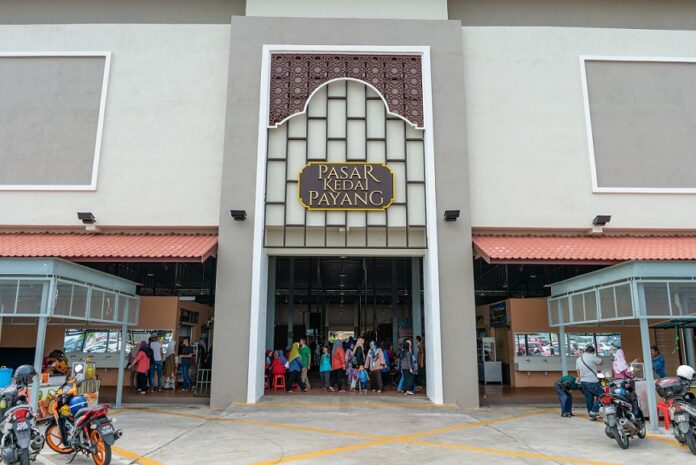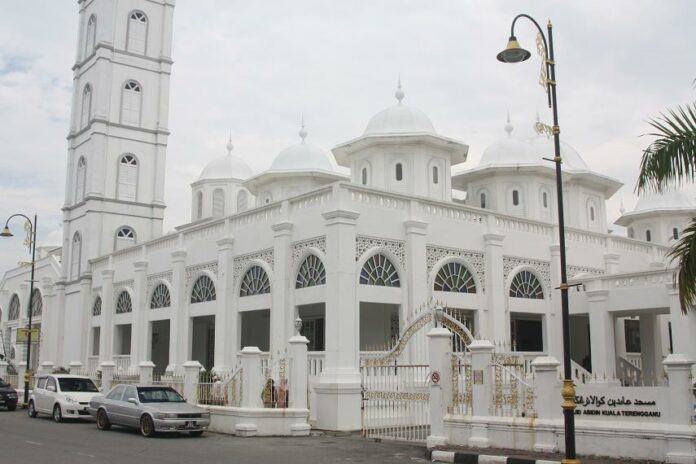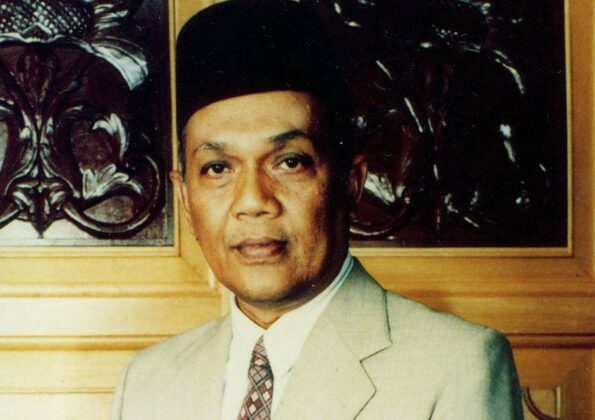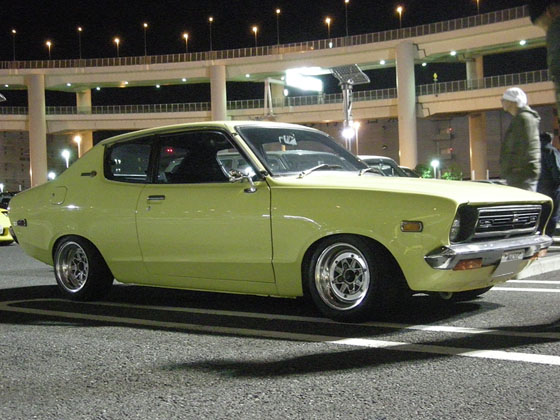A few days before Eidulfitri, people will gather at Pasar Payang, Kuala Terengganu to shop for household essentials in their preparation for Raya and this includes shopping for Raya clothing. The name Pasar Payang originates from the name of boats used by fishermen since the early process of trade in Terengganu called “perahu payang.”
In 1964, it is developed as a marketplace lined with wooden stalls as a replacement market for hawkers from Pasar Besar Tanjung which was previously demolished. The opening of Pasar Payang was inaugurated by the 16th Sultan Terengganu who was also the 4th Yang di-Pertuan Agong, Almarhum Sultan Ismail Nasiruddin Shah ibni Almarhum Sultan Haji Zainal Abidin III Mu’azzam Shah on 31st August 1968.

A recent picture of Pasar Payang with a more modern look
The lower level of Pasar Payang sells groceries, perishables and food items such as fish, vegetables, dried food and traditional desserts. Whereas on the upper level is where the main attraction is, where it sells apparel and clothing especially Raya clothing, batik Terengganu, silk and woven Malay songket.
As for Hajah Ramlah, she prefers to sew Raya clothes for her children and husband herself. Even before the beginning of the month of Ramadhan, she has started and completed sewing Raya clothing for her whole family. That is more important because as soon as Ramadhan begins or when the last 10 nights arrive, she could then focus on her worship and preparation for Raya.
*****
“Dad, is Raya really tomorrow?” Khairul asked excitedly.
Ustaz Mad giggles and replied: “I’m not sure myself. We have to wait for the announcement by Datuk Ahmad Zainal Abidin Muhammad Yusof, Keeper of the King’s Seals later tonight.”
After Maghrib, Ustaz Mad and his family are all gathered in front of the television. The excitement and anticipation are akin to watching the final football match between Italy and West Germany in the 1982 FIFA World Cup which took place in Bernabéu Stadium, Spain. “Do you think it’s Raya tomorrow?” Khairul asked Zul. “You are all muddled up since morning. Shh…it’s starting.” Zul chided Khairul, shushing him. Khairul scowled sullenly.
“In fulfilling the order of Seri Paduka Baginda Yang di-Pertuan Agong after being approved by Duli-Duli Yang Maha Mulia Raja-Raja, henceforth, I hereby announce that the date for Raya for states across Malaysia falls on Saturday, 30th June 1984. That’s all, wassalamu ‘alaikum warahmatullah wabarakatuh…”
Blasts and rumbles of fireworks followed the ending of the announcement. That night, Kampung Kubang Kekura and its surrounding area are filled with dazzling colours of fireworks.
*****

Abidin Mosque, Kuala Terengganu
“Allahu akbar, Allahu akbar, Allahu akbar…” the takbir could be heard breaking the stillness of the early cold morning. The Prophet PBUH said:
زَيِّنُوا أَعْيَادَكُمْ بِالتَّكْبِيرِ
“Beautify the two Eid with takbir.” [1]
“The takbir sounds so good and pleasant right?” Mi declared looking at Zul asking for his opinion. “It’s fine. I like the takbir from the National Mosque better.” Zul replied absent-mindedly, busy trying to fix his songkok as he stands and looks at himself in the mirror.
The first Eid prayer the Prophet PBUH performed was the Eidulfitri prayer in the 2nd year of Hijrah. The time for the Eid prayer begins when the sun rises and continues until the sun is approaching its zenith. This is in accordance with the hadith from al-Barra’ raḍiyallāhu ʿanhu, he said, I heard the Prophet PBUH said:
إِنَّ أَوَّلَ مَا نَبْدَأُ فِيْ يَوْمِنَا هَذَا أَنْ نُصَلِّيَ
“The first thing we do on this day of ours is to pray,” [2]
However, it is sunnah to perform the Raya prayer a bit later after the sun has risen above the height of a spear as explained by Shaykh Shaykh Saʿīd bin Muḥammad Bā ʿAlī Bā ʿIshn in Sharh al-Muqaddimah al-Ḥadramiyyah. [3]
Zul and his siblings scrambled to get into the bathroom first to take their shower. Each didn’t want to be left and wanted to go to the surau to perform the sunnah Eidulfitri prayer. Raya clothing for the children and her husband has been prepared and ironed by Hajah Ramlah. Everyone was delighted and happy to wear their new clothes. Ustaz Mad put on a little of his atar perfume on his sons before going to the surau. “It’s good to wear some perfume. It’s a sunnah in the morning of Raya.” He explained to his children.
Just as it is so on Fridays, it is also sunnah to wear perfumes and beautiful clothes on Raya day. The only difference is, it is sunnah to wear the best clothing one owns not necessarily for it being white unlike the sunnah on Fridays. [4]
After the sunnah Eid prayer, Ustaz Mad and his family went to visit his father, Haji Bakar. This is the first must-visit house for them to visit during Eid. Ketupat, rendang and tapai are among the special meals served on the table. Whilst, Nasi Dagang Ikang Aye is a definite main dish.
“Everyone, come gather around. I want to give some duit raya (green envelope),” Haji Bakar called all his grandchildren chuckling. His grandchildren came scurrying off leaving their half-eaten meals to shake his hands and receive their money.
On the first day of Eid, it is usually filled with visits to family and friends as well as neighbours. There’s no need to worry about what to have for breakfast, lunch or dinner, for there are sumptuous meals at every house! Ustaz Mad didn’t forget to also visit the people from among the needy such as Pok Leh. He would give some money as well as special Raya meals for Pok Leh and his family. “We should never forget the needy even while we are happy and celebrating.” Ustaz Mad reminded his children.
After the Zohor prayer, Ustaz Mad brought his family to visit the official residence of the Terengganu Chief Minister, Tan Sri Wan Mokhtar Ahmad who is also his former teacher. It has been his custom to visit the Chief Minister’s house every Raya. His profession as a Religious Visiting Teacher enables him to get to know and grow close with dignitaries and officers from Islamic Religious and Malay Customs Council Terengganu (MAIDAM) and the State of Terengganu Mufti Department.

Almarhum Dato’ Sri Amar Diraja Tan Sri Wan Mokhtar Wan Ahmad, Terengganu’s former Chief Minister
“The chicken here is so good. I want to have some more if I can. Kikiki…” Khairul whispered to his brother, Zul. “Man, you’re hopeless. Shh… you’re too loud!” Zul retorted pinching his mischievous brother. Incidentally, Tan Sri Wan Mokhtar overheard the brothers’ conversation and promptly interjected, “You’re welcome to help yourself to second servings. After all, we’ve prepared everything for the guests,” Zul and Khairul couldn’t help but smile from ear to ear after being graciously acknowledged by their host, the Chief Minister himself. They were quite pleased indeed.
Afterwards, Tan Sri Mokhtar gave an RM1 note to Zul and each of his siblings. They couldn’t believe their eyes; they were surprised as they looked at the money given to them. In the 80s era, RM1 is a lot of money. After chatting for a while, Ustaz Mad asked to take his leave for there are quite a few other houses left for them to visit.
Their father’s green Datsun Sunny 120Y with the plate number BBD 2949 sped out of the Terengganu Chief Minister’s official residence. Their next destination is Ayoh Long Haji Mad Gemok’s house, which is their uncle’s house. Ayoh Long Haji Mad Gemok is a wealthy man. All his children, Nafisah, Kak Re, Abang Din, Abang Mi, Kak Dah and others are all well-educated and well-behaved children. Unlike the persona of Zul and his brothers, a group of rowdy boys.

This is the car model of Ustaz Mad’s car
He would always treat his nephews and nieces with the most delectable dishes for Raya. However, on that particular day, Zul and his siblings are already worn out. They are stuffed after feasting at Tan Sri Wan Mokhtar’s official residence.
“Dad, is there a lot more houses left? I think I’m about done.” Zul sighs, drooping slightly, leaning his head on Mi’s shoulder. “We’re done. We are going home now.” Ustaz Mad answered.
That night, after performing the Maghrib prayer in congregation, Zul and his siblings gathered to count their duit raya. All the money collected are divided where a portion is kept in Bank Simpanan Nasional and the rest are used for their daily expenses.
An interesting affair in Kampung Kubang Kekura, the six-day fasting in Syawal is performed together by the elders starting on 2nd Syawal. Rasullullah PBUH said:
مَنْ صَامَ رَمَضَانَ ثُمَّ أَتْبَعَهُ سِتًّا مِنْ شَوَّالٍ كَانَ كَصِيَامِ الدَّهْرِ
“If anyone fasts during Ramadan, then follow it with six days in Shawwal, it will be like a perpetual fast.” [5]
Imam al-Nawawi rahimahullah when commenting on this hadith stated that this hadith is the evidence presented in madhhab Shāfiʿī, Ḥanbalī and Dāwūd al-Ẓāhirī in stating that it is sunnah to fast for six days in Syawal and the rewards of it are it is as though one has fasted for a whole year according to another hadith of the Prophet PBUH which states that each good deed is multiplied by ten (أَنَّ الْحَسَنَةَ بِعَشْرِ أَمْثَالِهَا). [6]
On 7th Syawal, those who have completed their fasting would celebrate together as if it was the 1st Syawal. The activity that they would never miss is to visit the graves. Among the grave of the scholars that people love to visit is in the Tok Khatib Siput graveyard.
Syeikh ‘Atiyyah Saqr in his fatwa Ahsan al-Kalām fī al-Fatāwā wa al-Aḥkām, detailed an explanation regarding the ruling of visiting the grave on Eid. According to him, the original ruling for visiting the grave is sunnah, for it would act as a reminder of the hereafter. He concluded that visiting the grave after performing the sunnah Eid prayer, if done for the purpose of reminding ourselves and remembering those who have passed away, as well as asking for blessings from Allah SWT for them, then all of these are permissible for men.
As for women, he ruled it makruh (discouraged) if there is fear that prohibited matters could happen such as mourning and others. If the prohibited matter is unavoidable, then it is prohibited.
As for visiting the grave after performing the Eid prayer to remind them of the sadness and loss as well as receiving condolences at the grave or by building a shed or place to receive condolences, then it is prohibited. The reason is receiving condolences is restricted, whether the restriction is in the form of prohibition or makruh (discouragement). Likewise, it is restricted for on the day of Eid, it is supposed to be a day of celebration and happiness of which one should not feel sad.
______________
[1] Narrated by al-Ṭabarānī dalam al-Muʿjam al-Awsaṭ, no. 4373. [2] Sahih al-Bukhari (908) [3] Shaykh Saʿīd bin Muḥammad Bā ʿAlī Bā ʿIshn. Sharh al-Muqaddimah al-Ḥadramiyyah, p. 421. [4] Ibid., 422. [5] Sahih Muslim (1164) [6] See Al-Minhaj Syarh Sahih Muslim, (8/56). As for the rewards of fasting as if one fasted the whole year, it is understood as the following: Every good deed is multiplied by 10 and this means 30 days X 10 = 300 and the sunnah fast is 6 x 10 = 60. This makes the sum of it as 360 and from this calculation, it is as though one fasted for a whole year (according to hijriyyah calculation). Wallahu a’lam.